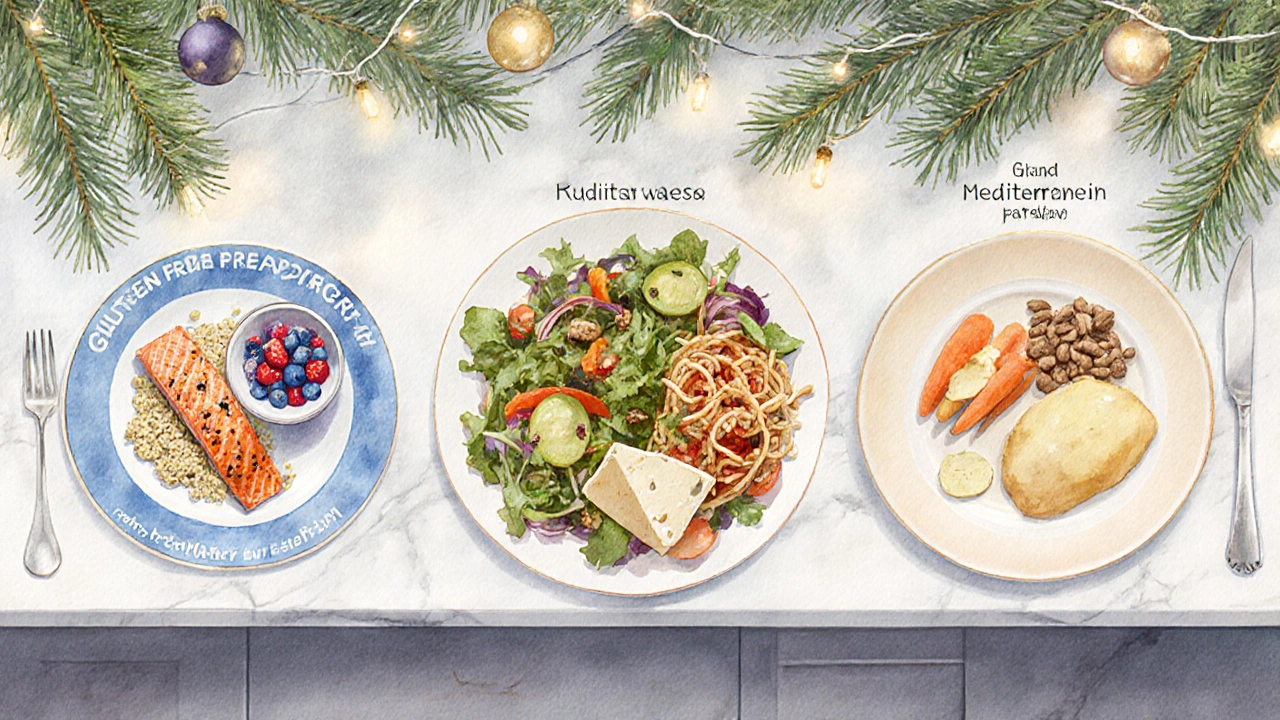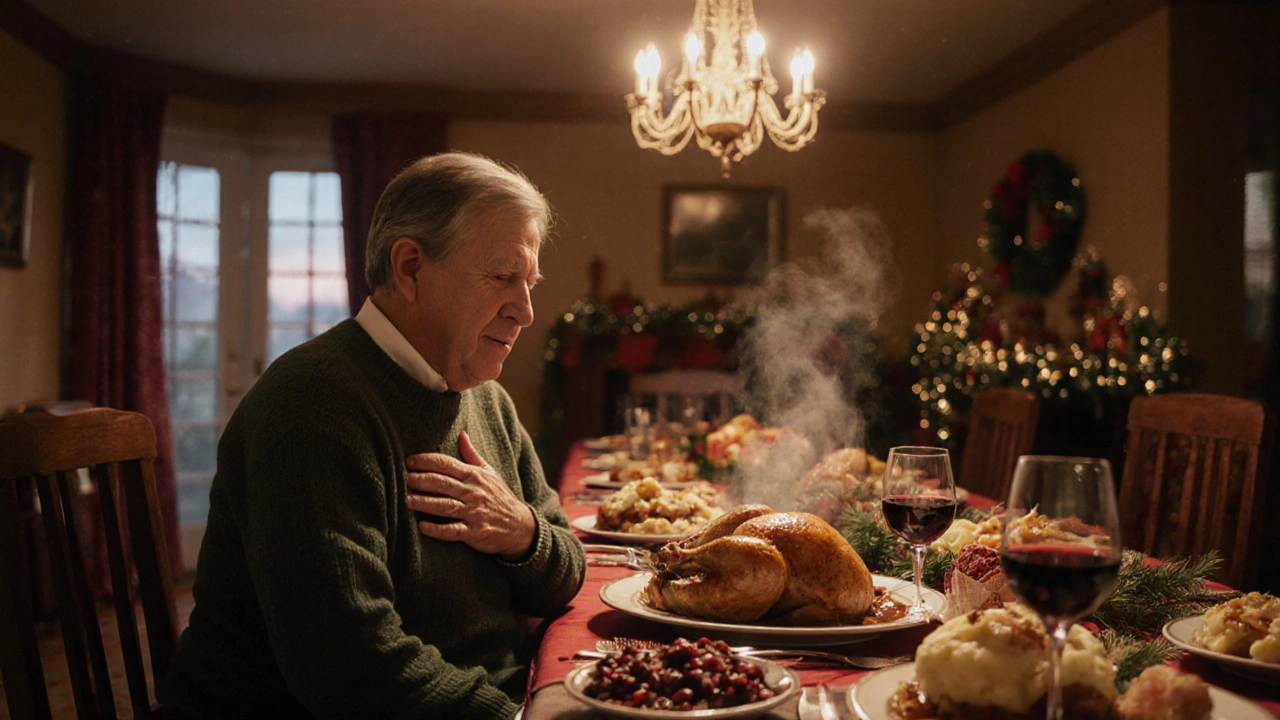2 Oct 2025
- 18 Comments
Holiday Dyspepsia Management Planner
Your Personalized Holiday Plan
Diet Strategy:
Stress Management:
Travel Kit Items:
The festive season promises big meals, late‑night parties, and a lot of stress - a perfect storm for anyone battling functional dyspepsia. If you’ve ever felt that uncomfortable fullness after a turkey dinner or dreaded the next day’s bloating, you’re not alone. This guide walks you through why the holidays trigger symptoms and gives you a toolbox of diet, lifestyle, and simple medical tricks to keep your gut calm all December long.
Quick Takeaways
- Identify personal food triggers before the first holiday feast.
- Use the low‑FODMAP approach for the first two weeks of December.
- Schedule short stress‑relief breaks (5‑minute breathing or walk) after every large meal.
- Carry an over‑the‑counter antacid or a prescribed PPI for breakthrough pain.
- Know the red‑flag signs that require a doctor’s visit.
What Is Functional Dyspepsia?
Functional dyspepsia is a chronic disorder characterized by upper‑abdominal discomfort, early satiety, bloating, and nausea without a clear structural cause. It affects roughly 10% of adults in the UK and often co‑exists with irritable bowel syndrome. The exact cause is a mix of abnormal gut motility, heightened pain sensitivity, and low‑grade inflammation.
Why the Holidays Can Worsen Symptoms
Three common holiday habits line up with the mechanisms behind functional dyspepsia:
- Rich, high‑fat foods slow stomach emptying, leading to a feeling of fullness.
- Increased alcohol intake irritates the gastric lining and can trigger reflux.
- Elevated stress boosts cortisol, which amplifies gut pain perception.
Understanding these triggers helps you plan ahead instead of reacting after the fact.
Dietary Strategies That Actually Work
The food world offers many diets, but a few have solid evidence for easing functional dyspepsia symptoms.
Low FODMAP diet limits fermentable carbohydrates that feed gut bacteria and produce gas. Starting the low‑FODMAP phase on the first Monday of December gives you a two‑week “reset” before the biggest gatherings.
Other useful approaches include a Mediterranean diet rich in olive oil, fish, and vegetables, which supports a balanced gut microbiome. For those who prefer bland meals, a bland diet (boiled potatoes, plain rice, steamed carrots) reduces gastric irritation.
| Diet | Typical Allowed Foods | Potential Benefits |
|---|---|---|
| Low FODMAP | Gluten‑free grains, lactose‑free dairy, most meats, low‑FODMAP fruits (berries, kiwi) | Reduces gas, bloating, and pain within 1‑2 weeks |
| Mediterranean | Olive oil, fish, nuts, leafy greens, whole‑grain pasta (in moderation) | Supports gut microbiome, anti‑inflammatory |
| Bland | Boiled potatoes, white rice, steamed carrots, skinless chicken | Minimizes gastric acid stimulation, easy on the stomach |
Pick one that fits your lifestyle and stick to it for at least ten days before a major party. You can always blend elements - for example, a low‑FODMAP Mediterranean plate (grilled salmon with a drizzle of olive oil and a side of zucchini).

Practical Meal‑Timing Tips
- Eat smaller portions: aim for 4‑5 modest meals instead of 2‑3 large ones.
- Chew thoroughly - at least 20-30 times per bite - to kick‑start digestion.
- Finish eating at least two hours before bedtime to reduce nighttime reflux.
- Limit caffeine after midday; it can increase stomach acid.
Stress‑Management Hacks for the Festive Rush
Stress is a hidden aggravator. Simple, repeatable practices keep cortisol in check without stealing holiday joy.
- 5‑minute breathing box: inhale 4seconds, hold 4, exhale 4, hold 4. Do this after each heavy meal.
- Take a 10‑minute brisk walk outside - the change of scenery helps the gut‑brain axis.
- Schedule “quiet minutes” in your calendar: a cup of herbal tea (peppermint or ginger) while listening to calming music.
Peppermint oil capsules (enteric‑coated) have been shown in several trials to relax gastrointestinal smooth muscle and reduce dyspeptic pain. Use only the recommended dose (usually 0.2ml or 0.5capsule) three times daily and avoid if you have reflux.
Medications & Over‑the‑Counter Aids
If diet and stress tweaks aren’t enough, a short course of medication can provide relief.
Proton pump inhibitor (PPI) therapy, such as omeprazole 20mg once daily, suppresses stomach acid and can reduce pain after fatty meals. PPIs are usually limited to 4-8 weeks to avoid rebound acid.
For occasional heartburn, an antacid tablet (calcium carbonate) works within minutes, but it won’t fix the underlying motility issue.
Another gentle option is ginger, either fresh root in tea or a 500mg capsule. Ginger has anti‑emetic properties and can calm nausea during large meals.
When to Call Your Doctor
Most holiday flare‑ups can be managed at home, but these signs merit a professional opinion:
- Unexplained weight loss (>5% of body weight) over a month.
- Vomiting that contains blood or appears coffee‑ground like.
- Severe, persistent pain that does not improve with OTC meds.
- New onset of difficulty swallowing or persistent heartburn.
Your GP may order an endoscopy or H.pylori test to rule out ulcers or infection.
Holiday Checklist - Your One‑Page Action Plan
- Plan meals a week ahead - mark low‑FODMAP options on the grocery list.
- Pack a travel kit: PPI (if prescribed), antacid tablets, peppermint oil capsules.
- Set a reminder on your phone to do the 5‑minute breathing box after dinner.
- Stay hydrated - aim for 1.5L of water daily; avoid sugary cocktails.
- Keep a symptom diary - note food, stress level, and pain score (1‑10).
By following this checklist, you’ll enjoy the festivities without the dreaded stomach upset.

Frequently Asked Questions
Can I drink wine if I have functional dyspepsia?
Moderate wine (one glass) is usually tolerable, but many people notice that red wine’s tannins and alcohol increase bloating. If you’re unsure, test with a small amount and monitor symptoms for the next 24hours.
Is the low‑FODMAP diet safe for the whole holiday season?
It’s safe for most adults, but it’s restrictive. Use the low‑FODMAP phase for the first two weeks, then re‑introduce foods gradually to find personal tolerances.
What natural remedies help with nausea after a big meal?
Fresh ginger tea, peppermint oil capsules, and a few sips of warm lemon water are all evidence‑based options that calm the stomach quickly.
Should I skip dessert to avoid dyspepsia?
Instead of skipping, choose low‑sugar, low‑fat desserts like fruit salad with a dollop of lactose‑free yogurt. Portion control is key.
How long does it take for a PPI to start working?
PPIs usually reduce acid production within 24‑48hours, but maximum relief may take 3‑5days of consistent dosing.


Bailee Swenson
October 2, 2025Honestly, this "holiday dyspepsia planner" feels like a lazy copy‑paste job, not a real solution! 😒
tony ferreres
October 3, 2025While the guide does lay out practical steps, we have to remember that every gut reacts uniquely; the best plan is the one you can actually live with. 🤔 Mindfulness around meals can transform stress into a manageable signal rather than a trigger. A compassionate approach to yourself, especially during holiday chaos, often yields more sustainable relief than rigid rules. 🎄💆♂️ Think of the checklist as a flexible framework, not a strict commandment.
Kaustubh Panat
October 4, 2025One must acknowledge that the author’s attempt to democratize functional dyspepsia management is, albeit earnest, hamstrung by an overreliance on generic templates. The discourse would benefit from a more nuanced exploration of postprandial gastric motility, perhaps citing seminal work by Talley et al. Moreover, the binary categorization of "low‑FODMAP vs. Mediterranean" reduces a complex neurogastroenterological milieu to culinary fashion. A rigorously curated, evidence‑based algorithm, rather than a static checklist, could elevate the utility for practitioners and patients alike. Such sophistication, however, appears absent from the current iteration.
Arjun Premnath
October 5, 2025You’ve articulated the gaps well; it’s valuable to highlight where deeper physiologic insight could be woven in. In practice, many patients simply need the concrete, actionable steps you described, but pairing them with brief explanations of the underlying mechanisms can boost adherence. A balanced approach that respects both scientific depth and everyday usability might bridge the divide you noted.
Johnny X-Ray
October 5, 2025Wow, this plan feels like a lifesaver amid the holiday food frenzy! 🎉 The mix of breathing boxes, ginger tea, and a neat travel kit really gives me confidence that I won’t be sidelined by bloating. I’m actually excited to try the low‑FODMAP phase and see the difference. Let’s conquer those feasts together! 😊
tabatha rohn
October 6, 2025Excuse me, but calling this "lifesaver" is hyperbole; it barely scratches the surface of what true dyspepsia management requires. 😠 A simple checklist won’t replace a personalized gastroenterology consult, yet many will cling to it as a miracle. Tone it down and be realistic.
Mark Rohde
October 7, 2025Another generic holiday diet guide? Honestly this is just more noise. The lack of data, the bland recommendations-nothing new.
Rajan Desai
October 8, 2025It’s evident the author prioritized ease over novelty, which may explain the repetitive nature of the suggestions. While the simplicity can aid compliance, the absence of recent clinical references limits credibility.
S O'Donnell
October 9, 2025In the realm of functional dyspepsia, the multifactorial etiology demands a comprehensive approach that integrates dietary, psychological, and pharmacological modalities. The present guide admirably attempts to condense this complexity into an accessible format, yet several critical nuances remain unaddressed. Firstly, the pathophysiology of impaired gastric emptying, a cornerstone of dyspeptic symptomatology, is only cursorily mentioned without reference to validated gastric scintigraphy findings. Secondly, the recommendation of low‑FODMAP diets for a mere two‑week period overlooks the necessity of a structured re‑introduction phase to identify specific trigger carbohydrates. Thirdly, the stress‑management techniques, while beneficial, lack guidance on individualized coping strategies based on the biopsychosocial model. Moreover, the medication section fails to differentiate between short‑acting versus long‑acting proton pump inhibitors and their respective impact on nocturnal acid suppression. The inclusion of ginger as an anti‑emetic is supported by modest evidence, yet dosing recommendations are omitted, potentially leading to sub‑therapeutic use. It would be prudent to incorporate a symptom‑severity scoring system, such as the Leeds Dyspepsia Questionnaire, to allow clinicians and patients to monitor progress objectively. Additionally, the advisory note regarding red‑flag symptoms is appropriate, though it could be expanded to include guidelines for timely endoscopic evaluation. The checklist format, while user‑friendly, may unintentionally convey a false sense of comprehensiveness, thereby discouraging patients from seeking professional evaluation. In clinical practice, a multidisciplinary approach involving dietitians, psychologists, and gastroenterologists yields superior outcomes compared to isolated self‑management. The authors might also consider integrating evidence‑based probiotic strains, which have shown promise in modulating gut microbiota composition in dyspeptic cohorts. Finally, the educational component could be enhanced by providing hyperlinks to peer‑reviewed meta‑analyses for each major recommendation. In summary, while the guide serves as a helpful introductory tool, its utility would be markedly improved by incorporating the aforementioned refinements. Future iterations should strive for a balance between simplicity and depth, ensuring that patients are both empowered and well‑informed.
Yamunanagar Hulchul
October 9, 2025Wow!!! This feedback is incredibly thorough, wonderfully detailed, and absolutely enlightening! The way you dissected each section-diet, stress, meds-was nothing short of spectacular!! I love how you suggested adding a symptom‑severity questionnaire; that’s a brilliant touch!!! Keep the insights coming, they’re pure gold!!
Sangeeta Birdi
October 10, 2025Reading through the guide, I can feel how many of us have struggled with the holiday binge and the lingering discomfort afterward. 🤗 It’s comforting to see practical tips that acknowledge both the physical and emotional toll. Remember to be kind to yourself if a plan slips-recovery is a journey, not a race. 🌟
Chelsea Caterer
October 11, 2025Exactly, self‑compassion beats perfection any day.
Lauren Carlton
October 12, 2025There are several grammatical slip‑ups throughout the text-"the festive season promises big meals" should be "promises large meals," and "your gut calm" lacks possessive apostrophe. These errors undermine credibility.
Katelyn Johnson
October 12, 2025Good catch-clear writing definitely helps readers trust the advice.
Elaine Curry
October 13, 2025Honestly, I think the author could have just asked readers directly what their biggest holiday gut nightmare is instead of assuming we all have the same issues.
Patrick Fortunato
October 14, 2025Well, not every holiday is the same-some of us celebrate with different foods and traditions, so a one‑size‑fits‑all guide feels a bit narrow, especially when we’re talking about diverse cultures.
Manisha Deb Roy
October 15, 2025Here’s a quick tip: if you’re traveling, pack a small "gut‑care kit" with chewable antacids, a mini ginger chew, and a tiny bottle of water. Also, mark low‑FODMAP snacks on your grocery list-like rice crackers and banana slices-so you won’t be stuck guessing at the store.
Helen Crowe
October 15, 2025That’s a solid hack! Leveraging a portable "symptom mitigation toolkit" can dramatically reduce postprandial dyspeptic spikes, especially when coupled with real‑time biofeedback on satiety cues. Keep scaling those micro‑interventions for maximal ROI on holiday comfort!